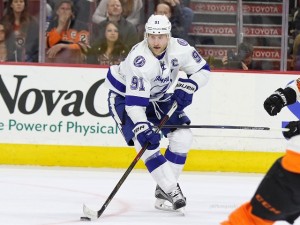For Tampa Bay Lightning forward Jonathan Drouin, the start of the 2016-17 season marks the beginning of a new chapter in his NHL career.
One in which he can put the events of last season’s trade request behind him and focus on his future with the Lightning. A closer look at the obstacles faced by Drouin and the Lightning during the early stages of his career shows how the team’s strengths led to Drouin’s eventual trade request. Ultimately, it was how both sides reacted to the situation that now gives Drouin the chance to have his most productive season in a Lightning uniform in 2016-17.
Drouin’s 2015-16 Season Took a Surprising Turn

After a promising start to the 2015-16 season when Drouin scored six points in his first five games, an injury slowed his progress and by the end of December, he had scored just eight points in 19 games. A day after being sent down to the Syracuse Crunch in the American Hockey League, his agent, Allan Walsh, released a statement revealing a trade request he made on behalf of Drouin back in November.
The hockey world erupted with speculation about where the left winger would be headed and this increased on Jan. 20 when the Lightning suspended him without pay after he failed to report for a game with the Crunch that evening. Despite rampant rumors about Drouin’s future, the Lightning did not move him at the trade deadline and he remained suspended indefinitely.
The “Why” Behind Drouin’s Trade Request
A look back at Drouin’s career up until that point provides some perspective behind the decision to make the trade request. The beginning of Drouin’s time in Tampa Bay did not start like one often expected for a player drafted third overall as he was in the 2013 NHL Entry Draft. While most players picked that high are headed to a franchise that is struggling, giving a young player the prime opportunity to be a contributor early, that was not the case for Drouin with the Lightning.
Despite an 18-26-4 record in the lockout-shortened 2012-13 season—one which also saw the team fire head coach Guy Boucher and the promotion of Jon Cooper—the Lightning were a better team than its record reflected. Franchise players like Steven Stamkos, Victor Hedman and Ben Bishop had a strong supporting cast of emerging young forwards like Tyler Johnson, Alex Killorn, Nikita Kucherov and Ondrej Palat. Yzerman was also able to add veteran forwards into the mix, including Brian Boyle, Ryan Callahan and Valtteri Filppula. This meant cracking the Lightning lineup as an 18-year-old would be more challenging than normal.

Drouin was unable to make the Lightning’s roster at training camp in 2013-14 and returned to the Halifax Mooseheads in the Quebec Major Junior Hockey League. After reaching the pinnacle of major junior hockey in 2013 when he helped the Mooseheads win the Memorial Cup, Drouin returned to juniors and watched as his former linemate, Nathan MacKinnon (drafted first overall in 2013), made the leap to the NHL and had an immediate impact with the Colorado Avalanche, winning the Calder trophy.
Drouin made his NHL debut during the 2014-15 regular season, but saw just over 13 minutes of ice time per game and registered just 32 points in 70 contests in a limited role. Then during the Lightning’s run to the 2015 Stanley Cup Final, Drouin was a healthy scratch most nights, playing just a shade above 10 minutes per game and going scoreless in six appearances. His two-way game in the playoffs also continued to raise questions, as he finished with a minus-6.
Cooper and the Lightning dressed who they believed gave them the best shot to win each night and fell just two wins short of winning the Stanley Cup in the end. At the same time, Drouin, then 20-years-old, almost certainly questioned his role with the organization and how he fit into the team’s future plans after being passed over in those important games.
In short— the atmosphere was prime for Drouin’s trade request — even though the player and organization never intended for things to get to that point when he arrived in Tampa Bay.
A Lesson Learned: How Drouin and the Lightning Handled the Situation
While the decision to request a trade and refuse to play in the AHL was one that reflected poorly upon Drouin at the time, in retrospect, what he did and how the Lightning handled it was the turning point in his maturity as a person and career as a hockey player. It also has the potential to provide a lasting positive effect on the franchise if the team is able to re-sign him before he becomes a restricted free agent in July.
When trade speculation began to emerge, it would have been easy for Yzerman to take a hasty approach and move an unhappy player out of town, but he sat back and held his cards. From Jan. 20 through early March, Drouin remained separate from the franchise and was reportedly back in Montreal skating and training at Concordia University. While Yzerman listened to trade offers up until February’s trade deadline, perhaps the most important thing he did was wait. It gave Drouin time to reflect on the situation and kept the team from acting on emotion to move a promising young forward.
The trade deadline passed and in the first week of March, Drouin reached out to Yzerman and communicated his willingness to return to the organization. In a brief stint with the Crunch, Drouin’s spirited effort and improved play made him a favorite to be a late-season call-up. As the Lightning battled injuries at the end of the regular season, Drouin made his return to the NHL and had an immediate impact in the team’s final two regular season games. In the playoffs, Drouin averaged over 17 minutes of ice time per game over 17 contests and tallied 14 points. His intensity on both ends of the ice and reportedly improved attitude off of it were praised.
Despite the Lightning being eliminated from the 2016 Eastern Conference Final in seven games by the Pittsburgh Penguins, Drouin thrived when given the opportunity to play a meaningful role with the team at the most important point of the season.
Drouin Poised for Breakout Season in 2016-17
With trade speculation behind him as he enters the final year of a three-year, entry-level contract, Drouin is set to have a career season if he is able to stay healthy in 2016-17.

After his performance in the 2016 playoffs and with Ryan Callahan expected to be out with an injury until mid-November, Drouin seems to be a lock to start the season on one of the team’s top two lines.
One of Drouin’s strengths has always been his playmaking ability and he’s a leading candidate to be a winger alongside Stamkos during even strength and power play situations. If the pair clicks like they did briefly to start 2015-16, it would be the first time Stamkos has had a go-to set-up man since Martin St. Louis was traded in the 2013-14 season. At the same time, Drouin must also continue to improve his game defensively and be weary of taking the ill-advised penalty in important situations.
The growing pains Drouin and the Lightning went through during the 2015-16 season were something neither one wanted, but a sequence of events that seemingly had to occur to bring both sides together.
In the end, Drouin and the Lightning are better because of it.